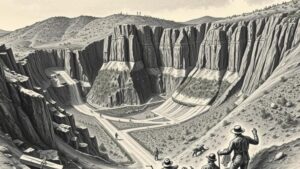Spotting Alteration Zones Around Caldera Systems for Silver Potential
Spotting Alteration Zones Around Caldera Systems for Silver Potential
Caldera systems, formed through volcanic activity, present unique opportunities for mineral exploration, particularly for precious metals like silver. Understanding the alteration zones surrounding these systems can significantly boost the chances of finding economically viable silver deposits. This article elucidates the formation of these alteration zones, the process of identifying them, and their connection to silver mineralization.
Understanding Calderas and Associated Alteration Zones
A caldera is a large depression formed when a volcano erupts and collapses. This geological feature typically results in a complex suite of alteration zones that can enrich surrounding minerals. Alteration zones are regions where the original rock has been chemically altered by hydrothermal fluids, which can also lead to the deposition of precious metals such as silver.
Common types of alteration include:
- Silicification: The introduction of silica into rocks, often enhancing permeability and hosting mineralization.
- Clay alteration: The transformation of primary minerals into clays, which can indicate proximity to hydrothermal systems.
- Propylitization: The alteration of volcanic materials to form epidote and chlorite, and can often be associated with mineral deposits.
Geological Indicators of Alteration Zones
Several geological indicators can signal the presence of alteration zones around calderas. Identifying these markers is crucial for pinpointing areas with silver potential. e indicators include:
- Hydrothermal Alteration Patterns: Studying the alteration mineralogy can help delineate zones rich in precious metals. For example, a study at the Creede caldera in Colorado revealed that specific hydrothermal alteration (like advanced argillic alteration) correlated strongly with high silver grades.
- Structural Geology: The structural alignment of fractures and faults around calderas can enhance fluid migration, leading to mineralization. An example can be found in the El Salvador caldera in Chile, where fault systems have guided mineral-laden fluids.
- Geochemical Anomalies: Soil and rock sampling can uncover anomalies in silver concentrations, often found in alteration zones. Notable discoveries in the VMS (Volcanogenic Massive Sulfide) deposits in Canada highlight the relevance of geochemical analysis.
Exploration Techniques for Identifying Silver Potential
Exploration within alteration zones requires a combination of geological and geophysical techniques to increase the likelihood of successful mineral discovery. Techniques include:
- Geological Mapping: Detailed mapping to identify rock types and alteration signatures is foundational. For example, mapping at the Cripple Creek caldera resulted in the identification of key zones that were later mined for high-grade silver.
- Remote Sensing: Utilizing satellite imagery and aerial surveys can give insights into larger-scale alteration patterns not easily visible on the ground. Techniques such as ASTER (Advanced Spaceborne Thermal Emission and Reflection Radiometer) imaging have proven effective in identifying hydrothermal systems.
- Geophysical Surveys: Methods like electromagnetic surveys can identify subsurface structures associated with mineralization. Case studies in Nevadas Comstock Lode illustrate the effectiveness of these techniques in locating silver-rich veins.
Case Studies of Successful Silver Exploration
Several case studies illustrate the successful application of the aforementioned techniques in identifying silver potential within alteration zones:
- The San Javier Project, Mexico: This project utilizes geological and geochemical mapping alongside drilling to discover silver-rich deposits located near a caldera system.
- The Barberton Greenstone Belt, South Africa: Here, extensive geological mapping and sampling around ancient calderas have led to significant silver finds, demonstrating the enduring potential of these systems.
Conclusion and Actionable Takeaways
Identifying alteration zones around caldera systems provides a strategic advantage for silver exploration. By leveraging geological indicators, employing advanced exploration techniques, and studying successful case studies, geologists can enhance their chances of discovering economically significant silver deposits.
For those involved in mineral exploration, consider the following actionable takeaways:
- Conduct thorough geological and geochemical surveys to establish baseline data.
- Use remote sensing technologies to cover larger areas efficiently.
- Collaborate with geophysicists to incorporate geophysical data into exploration strategies.
By adopting these practices, exploration teams can optimize their efforts in tapping into the rich potential associated with caldera-induced alteration zones.


